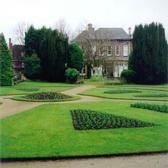Abbey Grounds, Abingdon
Region: South East
Owner Type: Local Authority
Funding Body: Heritage Lottery Fund; Local Authority
Year of Intervention: 1998 - 2006
Summary: Plans to repair and restore and to improve understanding and enjoyment of the Abbey Grounds in Abingdon are developed by an integrated team from the Vale of White Horse Council in consultation with the local community.
Description: At the time of the dissolution Abingdon Abbey was one of the seven largest and wealthiest Abbeys in the country. The area contains the nationally important Scheduled Ancient Monuments of the Benedictine Abbey of St Mary and the Abbey Gateway. The Abbey Gateway, Unicorn Theatre and Long Gallery remain standing while the foundations of the Abbey Church remain below ground. The area also contains the Abbey House, a 17th Century building, a folly and areas of formal garden laid out by E.J.Trendell between 1853 and 1900.
Issue: The local authority wanted to realise the full value of the grounds to the local community, to stimulate tourist activity and to provide visitor facilities for the users of the National Cycle Network and Thames Path. The site was not fully understood and lack of interpretation meant that the history and heritage value of the site was not easily appreciated. The site contained both heritage and ecological interests and was already a valued local amenity. The site was well used by the public, who may be sensitive to any changes.
Strategy: Good communication across departments and between members and officers was essential to the smooth running of the project. A Working Party of members and officers was set up to steer the project and agree its scope and content. Extensive public consultation was carried out through the district newsletter, press releases, radio interviews, public displays and meetings with user groups. The public were kept well informed of the archaeological and research work underway. The final Restoration Management Plan was informed by both the public consultation and the historical and archaeological research findings. The plans for the site were fully integrated with the strategies of the Environment Agency and English Nature. The project implementation will be kept in-house, which will allow existing key skills to be nurtured and developed. Post project maintenance will also benefit from continuity of management.
Outcome: The public consultation throughout the project has meant that the public are supportive and potential problems avoided and opportunities capitalised on. The proposals won Heritage Lottery Funding in October 2002 for a scheme to return the ground to their original layout as a Victorian ornamental park and garden.
Keywords: Repair, Reconstruction & Restoration, Research & Archives, Social Inclusion & Access
© English Heritage/Daniel Thompson

